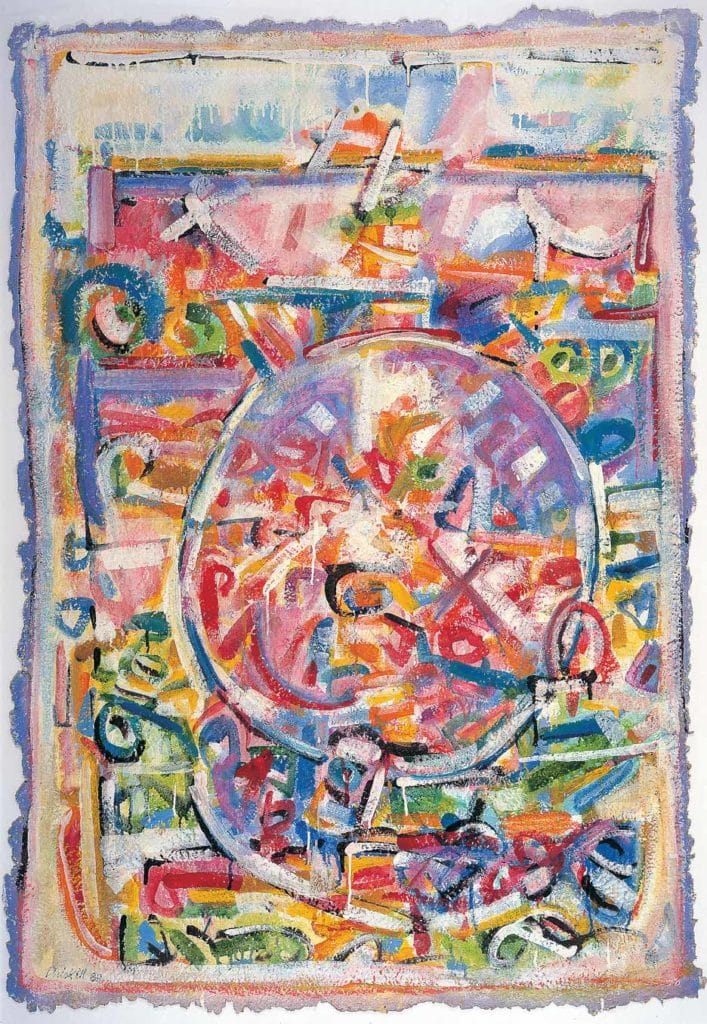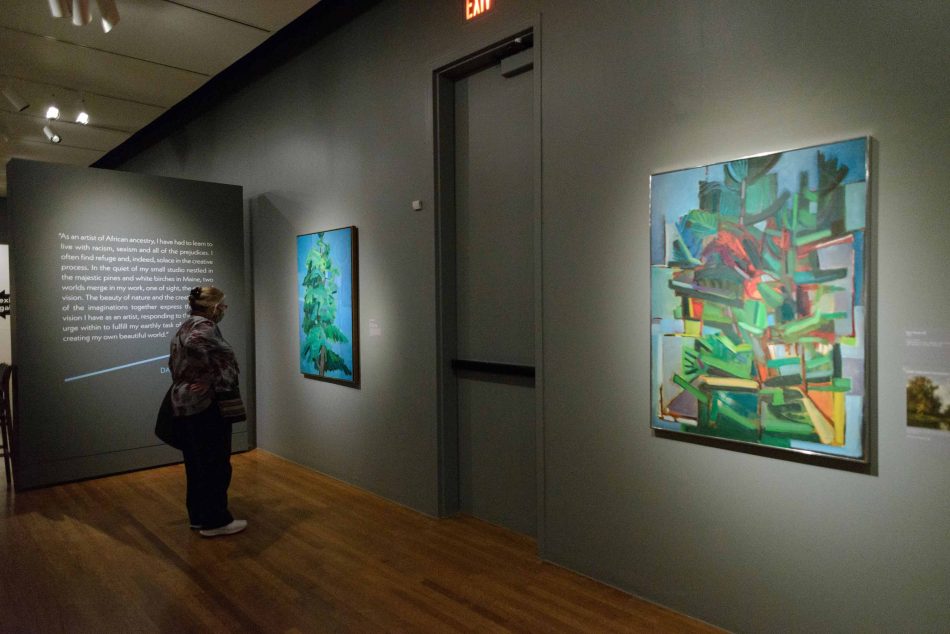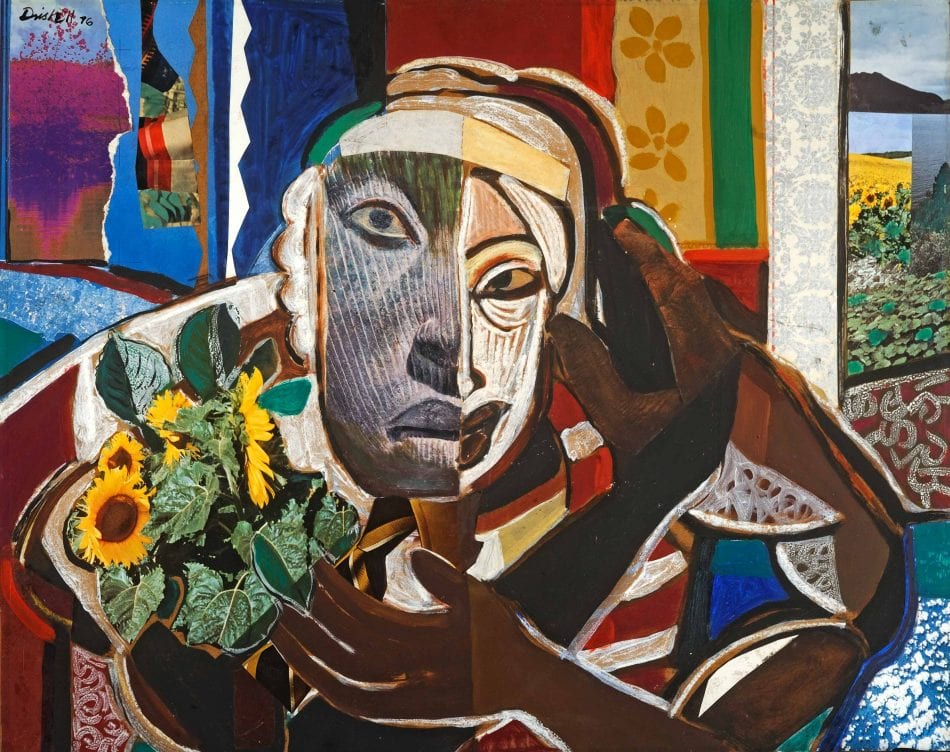
David Driskell, an acclaimed African American artist and educator, was born in 1931 in Georgia during the beginning of the Depression – the worldwide economic downturn that began in 1929 and lasted ten years. It was the longest and most severe economic depression the world ever experienced. Imagine how this awful event influenced Driskell’s life and work. I say this because it was clear to me that David Driskell cherished in nature the things that were enduring and beyond the material.
A case in point is his early and lifelong passion for painting pine trees, both the majestic southern pines of his youth in Georgia and then northern pines when he had a summer residency at Skowehgan School of Painting and Sculpture in 1953 in Madison, Maine. Driskell celebrated the beauty and endurance of the pine. It was so central to his art making that he chose to explore the pine tree for his MFA thesis work. He then went on to teach at the University of Maryland and retired from there in 1998. He loved that pines remain green throughout the year and that pine trees endure nature’s hardships that Driskell saw as a metaphor for his own life. It also ushered in for him the opportunity to increasingly experiment with abstraction. There was the linearity of the pine’s trunk and lyrical elements of branches interacting with the sky. Several of his pine trees usher in the first part of this exhibition.
The first part of the exhibition is titled “Icons of Nature” and we see that throughout this exhibit of Driskell’s paintings, prints and drawings there is always a return to nature’s forms. So like the southern and northern pines Driskell painted, the High Museum of Art, Atlanta, was one of the co-organizers of this exhibition along with the Portland Museum of Art, Maine. Museums of both south and north bring together more than 50 highlights from Driskell’s distinguished career, surveying the artist’s painterly practice from the 1950s forward.

I find that Driskell’s nature-based work, along with his homage-collage paintings honoring Jacob Lawrence and Romare Bearden, are Driskell’s strongest works. Small works like Water Stones of 1975 and Seascapes with Rocks from 2004 drew me in. Bold yet tender, they balanced perfectly between realism and abstraction. Driskell seemed so at home working on paper, whether in his extensive sketchbooks, two of which we have the opportunity to see, or in his drawings, prints and mixed water media works on paper. Again, I sense his comfort in using humble and readily available materials that call back his Depression-era childhood surviving hardships.

Driskell found stimulation for his artistic exploration in his activities as an influential curator, educator, and scholar, who tirelessly asserted the importance of Black artists to the history of American art.
“The art of black America has been a varied conglomeration of many interests, schools of thought and modes of expression. However, the activism of the new generation of artists prophesies the beginning of ‘grass roots art which may be embedded in the soil of discontent with social injustice and deprivation, and it also speaks of an oncoming sign that black people in America no longer accept the idea that they must look to whites to be the interpreters of a culture in which they have only participated as observers.”
David Driskell
This phrase is key: ‘that blacks no longer accept the idea that they must look to whites to be the interpreters of a culture.” So Driskell looked to his mentors, two giants of twentieth-century American art, Jacob Lawrence and Romare Bearden, both African Americans who celebrated the black experience in America, as pioneer Horace Pippin did before them. Two of the most beautiful and compelling works in this exhibition are Driskell’s homage paintings to them. I highlight Homage to Romare that brilliantly calls up Bearden’s astounding use of collage. Driskell combines two African masks vertically. The eyes are not aligned. I see in this that a black person must be of his/her culture with one eye and keep a lookout for what the white culture expects with the other eye. David Driskell first visited Africa and the ancient city of Benin in 1970. So the second part of this multi-museum survey “Icons of History” is demonstrated in such paintings as Homage to Romare.
There is much, much more to Homage to Romare. It is boldly frontal; the arms of the black woman encircle her with joyful exaggeration of form and scale. She holds a magazine picture of a sunflower bouquet in her arms. Other bold collage elements are strips of painted and printed paper in colorful stripes behind her suggesting a wall and windows to the outdoors. Lovely breathing space and a garden outside are suggested through such simple and deft means. It is the European avant-garde interpreted by him and his heroes. And to whom did the European avant-garde look? African sculptural masks. Driskell is simply pulling through the maize of sanctioned art history the truth of brilliant source material originally from the African continent.
The Cincinnati Art Museum states: “Although his work regularly appeared in galleries and museums during his lifetime in both solo and group exhibitions, his paintings and works on paper are united in this exhibition for the first time. This exhibition is the first major presentation of Driskell’s work since his death in April 2020 at the age of 88. Driskell lectured in Cincinnati in 2000, two years after a long career teaching at the University of Maryland, retired from there in 1998, when the Cincinnati Art Museum presented Narratives of African American Art and Identity: The David C. Driskell Collection.” “David Driskell is so esteemed for his influential contributions as a scholar and curator that his career as an artist is sometimes overshadowed,” says Julie Aronson, Curator of American Paintings, Sculpture, and Drawings who is overseeing the Cincinnati presentation. “Yet he was committed to his studio practice and responsive to wide-ranging influences from the history of art and his environment. Brilliant color, nuances of line, and varied textures imbue his art with visual impact and significance. We sense the profound joy he experienced in the creative process.”
–Cynthia Kukla